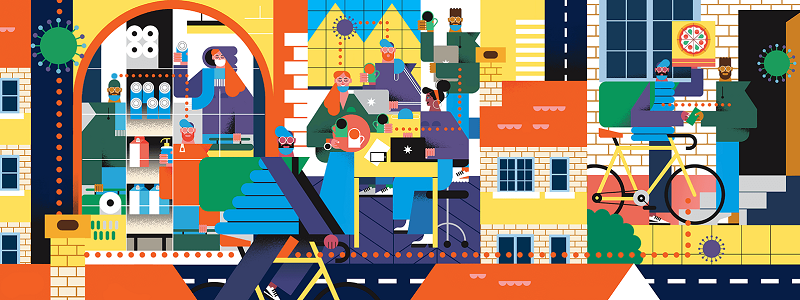
KNOWABLE MAGAZINE — The pandemic poses difficult questions whose outcomes depend on so many interconnected factors, including the unpredictability of individual humans' minds and behavior. Human behavior is a moving target: What our leaders and friends say and do today influences what we ourselves do tomorrow. Effects can loop back to alter causes in a complex tangle that's almost impossible for analysts to think through.
Instead of trying to analyze how a society functions from the top down, the new technique known as agent-based modeling tackles the problem from the other end, by focusing on the individuals themselves. Already, agent-based models have taken over fields as disparate as traffic planning, securities trading and war gaming, and their use is growing in economics and political science. And within epidemiology, such models are yielding fresh insights into the way epidemics spread and evolve, what public health officials can do to control the outcome and the likely economic consequences of the pandemic.
Setting up an agent-based model is simple in concept but daunting in practice. The first step is to create a population of software people that resembles the real population being studied. For several research groups, this means agent-based models that span the entire country.
"We have every person in the US, where they live, where they go to school, where they go to work," says Donald Burke, an epidemiologist at the University of Pittsburgh who helped develop one such model, known as FRED. Rather than copying reality exactly, though, FRED mimics its broad patterns. "There isn't a Don Burke living at this exact address," Burke explains. "But there is a person in their 70s living in a two-person household, with my income, in my census block." And that not-quite-Don-Burke goes to work not at Pitt, but at a nameless employer of a similar size whose employees commute from similar distances. (Other groups have developed similar models.)
Once they've created the basic model, researchers can use it as a platform to address whatever specific question they need to answer. For pandemic-related questions, they specify realistic probabilities, based on available data, that each cyber-person will do things like wear a mask or refuse a vaccine, given their age, ethnicity and location. Then they turn their agents loose to go to work (at office or home), shop, meet friends and carry out all the other activities of daily life.
As the agents live their cyber-lives, some will spread the virus to the people they contact, according to specified probabilities. After a few simulated weeks or months, the modelers can count up infections, hospitalizations and deaths to track the progress of the pandemic.
This approach not only offers predictions of the pandemic's future trajectory, it also can give insights into the effects of varying public health strategies. For example, Burke's team has modeled how the state of Iowa could best allocate a limited number of vaccine doses in order to slow the spread of the virus most efficiently. Health officials would need to vaccinate more aggressively in more densely populated parts of the state, they found, to counteract the natural tendency of the virus to spread more quickly where there are more people. Their model gives specific recommendations for how many vaccine doses should go to each medical center in the state.
Visualizing the Impact
Agent-based models don't just offer novel insights. They also make it easier for analysts to communicate their results, because their focus on individuals makes immediate sense to policymakers and the public. "If you see a map with individual humans on it, and the epidemic spreads with movement of red dots across a map, that's more understandable than seeing an equation or a graph," says Burke.
Even more powerfully, the spatial detail of such models means that decision makers can visualize the impact of their choices on their own constituencies. After a measles outbreak at Disneyland in California, for example, state Sen. Richard Pan cosponsored a bill in 2015 to require measles vaccinations for all schoolchildren unless they had a medical exemption. Pan used Burke's model to show other senators what a measles epidemic would look like in their hometowns with and without the measure. The bill passed, and immunization rates rose in California. "Sen. Pan has told us that having this tool was very important in conveying this idea," says Burke.
Read full story
This article is part of Reset: The Science of Crisis & Recovery, an ongoing series exploring how the world is navigating the coronavirus pandemic, its consequences and the way forward. Reset is supported by a grant from the Alfred P. Sloan Foundation.
This article originally appeared in Knowable Magazine on December 15, 2020. Knowable Magazine is an independent journalistic endeavor from Annual Reviews, a nonprofit publisher dedicated to synthesizing and integrating knowledge for the progress of science and the benefit of society. Sign up for Knowable Magazine's newsletter.
12/17/2020